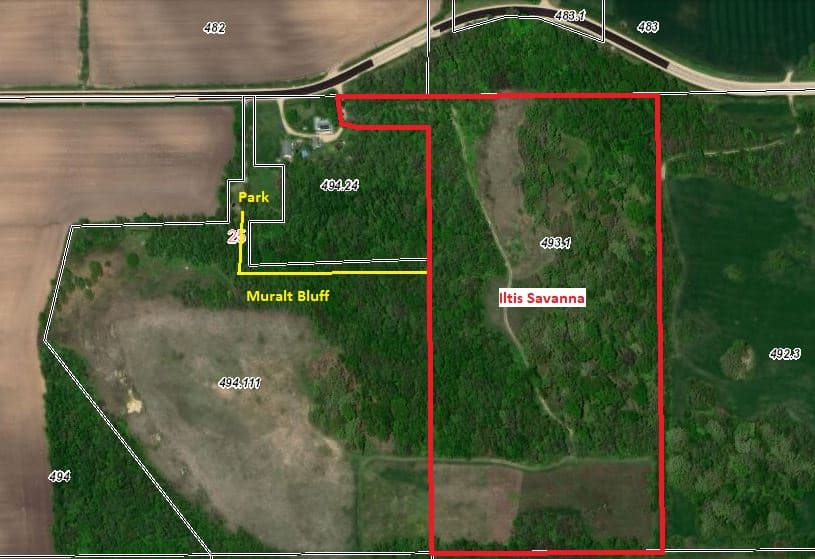
Photo credit: Jerry Newman
Iltis Savanna
Iltis Savanna is a 21.5 acre complex of woods, savanna and dry prairie that is adjacent to Muralt Bluff in the southeast quarter of Section 25 of Mt. Pleasant Township in Green County, Wisconsin. It was purchased by The Prairie Enthusiasts in December, 1999, and it is named for Dr. Hugh H. Iltis, eminent Professor of Botany at the University of Wisconsin – Madison and Director of the UW Herbarium from 1955 to 1993.
This is a challenging hike as it’s long and steep; there are no trails.
ACCESS & DIRECTIONS
Public access to Iltis Savanna is from the parking lot of Muralt Bluff, next to W2635 County F, between Monticello and Albany. Take the hiking path up the steep bluff to the top of the hill, and then walk east toward the oak trees.
Google Map
Description & Significance
Iltis Savanna was the most degraded of our sites upon acquisition, and it remains the most challenging. An aerial photo from 1939 shows a mostly open landscape, with so few open-grown oaks that they can be counted. Our fire regime has promoted the emergence of young oaks, to ensure that this savanna will endure into the 21st century. After significant efforts by members of the Prairie Bluff Chapter, native species are returning.
Notable Plants On This Site:
- Various specis of Rubus
- joe-pye weed (Eutrochium maculatum)
- hyssop
- shooting star
- bush clover
- various asters & goldenrod
- showy orchid (Galearis spectabilis)
- Indian pipe (Monotropa uniflora)
- little bluestem (Schizachyrium scoparium)
- prairie dropseed (Sporobolus heterolepis)
- lead plant (Amorpha canescens)
- Hill’s thistle (Cirsium pumilum var. hillii)
- wood betony (Pedicularis canadensis)
- bird’s foot violet (Viola pedata)
- prairie violet (Viola pedatifida)
- Ohio spiderwort (Tradescantia ohiensis)
- violet wood sorrel (Oxalis violacea)

Usage Policies
Allowed:
- Outdoor Recreation
- Hunting (for all species, no permit or reservation required)
Management
South of these oaks is a 4-acre former agricultural crop field that included a large sumac clone and a honey locust grove when we re-started active management in 2009. We used timed — twice in late summer — mowing to reduce the sumac to manageable numbers, which we then eliminated one-by-one. We hired a contractor in 2016 to uproot the locusts, which we piled and burned. See our Facebook page for a video, “One more acre for prairie.” We began planting this field to prairie in 2014 with seeds we collected at our other sites, with three subsequent plantings. Site preparation has been difficult due to deep-rooted brome grass and a seed bank of red clover.
As you walk east along the north edge of this field, the unmanaged woodlot to your left in an example of what happens when grazing animals are removed from a farmstead that has a few oak trees. Walnuts, hickories, cherries, cedars and basswoods eventually grow up, and the understory is filled in with raspberries, blackberries, dogwood, sumac, prickly ash and honeysuckle … lots of honeysuckle.
The core of Iltis Savanna is a mature bur, white and red oak savanna that occupies a north-south ridge with a thin limestone cap over sandstone. The oak structure remains, but 100 years of grazing by cows, pigs and horses eliminated almost all the floral element underneath. Some sedges and spring ephemerals like trout lily were all that remained under the oaks. Garlic mustard was a problem that we’ve controlled with prescribed fire. We thinned out the northern portion with a basswood harvest. Various species of Rubus quickly filled these open spaces, while hog peanut moved in to cover the south end with a blanket of vines. But slowly, in the past decade, we’ve seen the natives begin to reclaim the savanna: joe pye weed, hyssop, shooting stars, bush clover, asters and goldenrods. Showy orchids and Indian pipe can be seen most years.
A keen eye will make out a former farm dump on the side of the bluff, halfway down the hill. For ten years the chapter worked to clean out the trash: recycling fence wire and hauling off parts of cars, trucks, farm equipment, household appliances, toys, cans, bottles and broken glass. Finally, in 2012, we hired a contractor to bury what was left of the dump. There was not enough topsoil to cover it all, so a few truckloads of fill were brought in. We began to plant dry prairie species — little bluestem, dropseed and lead plant — into the thin soil. Hill’s thistle and wood betony are now common in this planting. But the fill contained reed canary grass and the sweet clovers, which were problematic in the lower portion.
Below the dump planting is a steep west-facing bluff. Restoration started at the top, clearing cedars and brush and seeding in native grasses and forbs. Between this bluff and the savanna is a strip of dry prairie dominated by little bluestem, with both bird’s foot and prairie violet, spiderwort, violet wood sorrel, asters, goldenrods and blazing stars.
